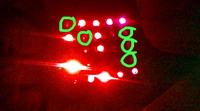
- Joined
- Jan 22, 2008
- Messages
- 53,105
- Helped
- 14,792
- Reputation
- 29,871
- Reaction score
- 14,291
- Trophy points
- 1,393
- Location
- Bochum, Germany
- Activity points
- 301,045
Column multiplexing achieves only 1:100 duty cycle, means 15 mA LED (peak) current translates to 0.15 mA average, helplessly dim.
Try to figure out the basic concept of multiplex displays!
Try to figure out the basic concept of multiplex displays!






